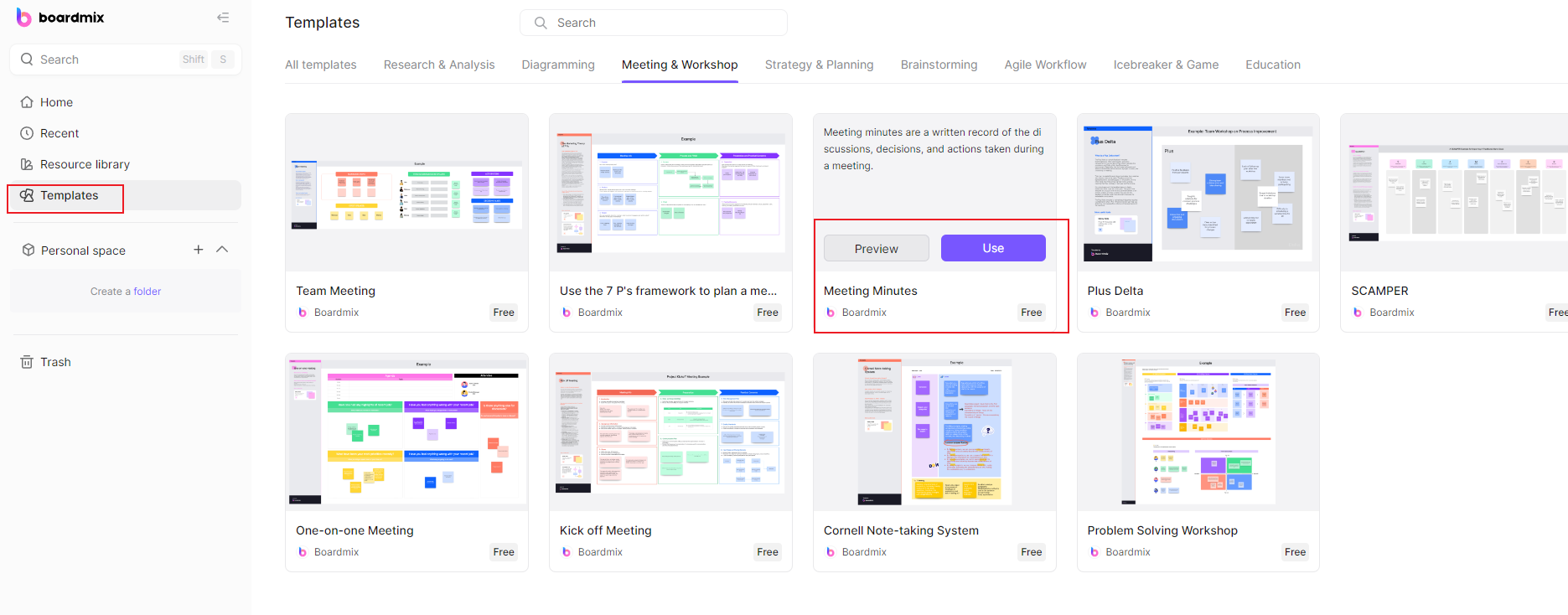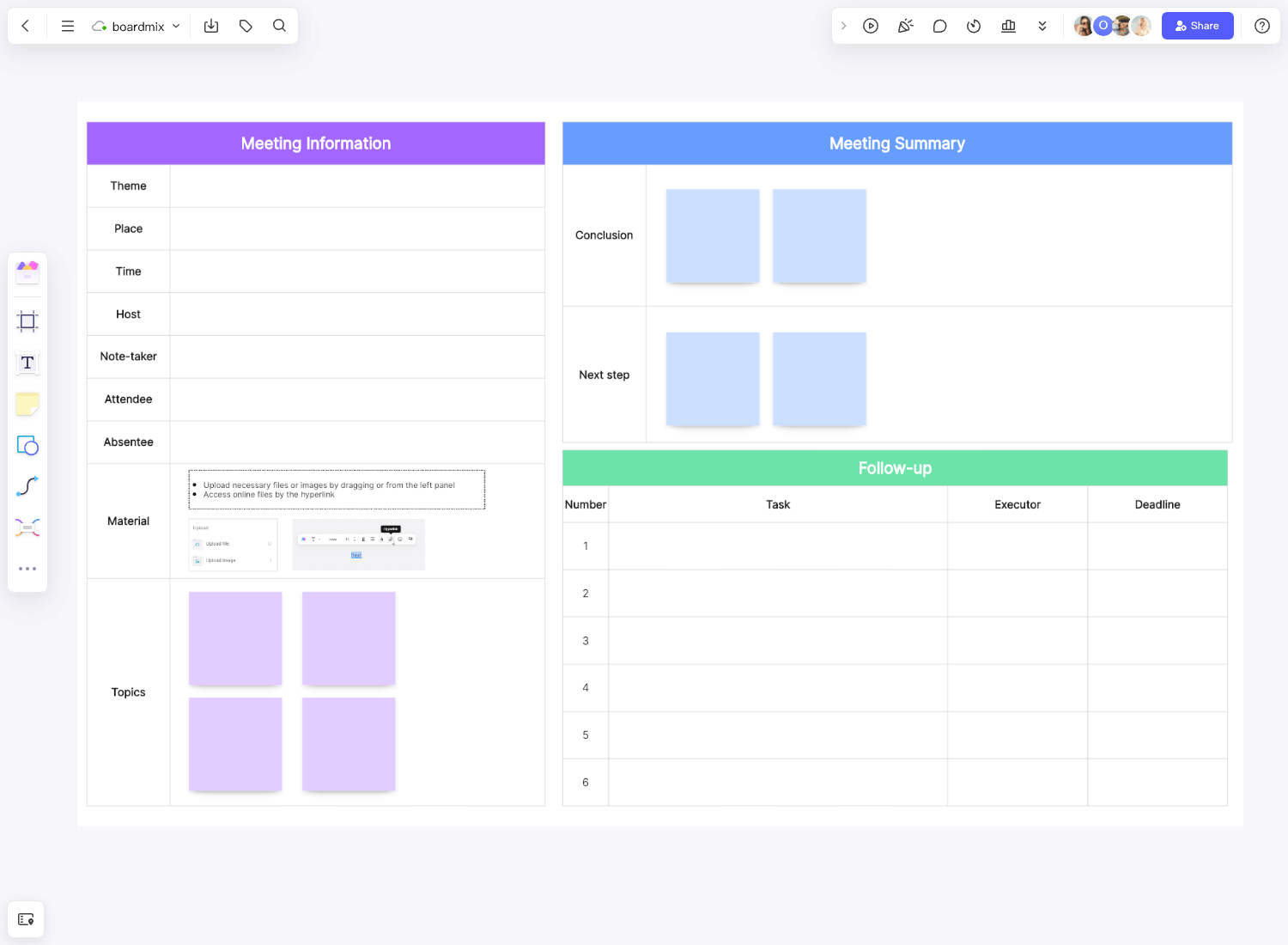Some people have a very good memory, but even these gifted people would have a tough time remembering every single thing that has been discussed during a meeting, especially a lengthy one. For this reason, taking down the minutes of a meeting has become standard practice. These days, there are even different kinds of meeting minutes templates that you can use to help you do the task more efficiently. Before we get into the template, let's first talk about meeting minutes.
What are the Meeting Minutes?

Build Meeting Mintues for Free
Minutes are the formal written record of a meeting, encompassing a complete account of discussions, a list of attendees, and accurate notes of each participant's statements. Key agenda points, like decisions, new goals, and deadlines, are also included to ensure comprehensive documentation.
What is the purpose of the meeting minutes?
Meeting minutes serve as essential written records for future reference. They allow project managers and team members to easily review details, clarify information, and keep all organization members updated on progress and plans. These comprehensive records foster transparency, cohesion, and effective decision-making, promoting successful collaboration in future discussions.
Meeting minutes serve multiple essential purposes within an organization. They ensure all members, even those not present at the meeting, stay updated on progress and plans, while clearly defining participant roles and establishing an easily-followed timeline. Additionally, meeting minutes fulfill legal requirements in certain cases, especially for large corporations where board meetings necessitate properly recorded minutes that can be used as evidence in court, if necessary. Regardless of the purpose, finding the right meeting minutes template is crucial to meet specific needs effectively.
Why are meeting minutes important?
Meeting minutes are of utmost importance for record-keeping, complying with organizational procedures, and providing a valuable reference for future endeavors or subsequent stages of ongoing projects. Meeting minutes provide comprehensive documentation that promotes effective communication, enhances accountability, and fosters seamless collaboration among team members and stakeholders.
Meeting attendees can refer to the minutes to verify details they may have forgotten or find clarification. Non-attendees can catch up by reading the comprehensive minutes, ensuring everyone stays informed.
Minutes are also very important for monitoring the performance of the organization or tracking the progress of a project. By using a well-designed meeting minutes template, all these functions can thoroughly be performed. The Boardmix meeting minutes template, for instance, is quite comprehensive and can be used for all these functions.
What should be included in meeting minutes?
There are several key things that you should include when taking minutes of a meeting. To make sure that you don't forget anything, it is best that you use a meeting minutes template as your guide.
It begins with the date and time of the meeting and a list of attendees. For attendees that have a special role, like the host or the note-taker, you can indicate this beside their name. When the meeting is over, remember to go back to this section and indicate the time at which the meeting finished.
The purpose of the meeting is then stated, followed by the agenda and an outline of all the topics talked about. The minutes are not a transcription so you don’t have to write everything word for word, but the crucial topics and ideas must be included.
Following that, the minutes should outline the decisions made in the meeting and the ensuing actions to be taken. A comprehensive conclusion includes specifying the date and venue of the next meeting, along with noting all relevant documents to be attached for reference and follow-up. These comprehensive minutes serve as a vital resource for team members and stakeholders to stay informed, track progress, and ensure successful project management and implementation.
3 Meeting Minutes Templates in Boardmix
Executive Summary Meeting Minutes
Executive Summary Meeting Minutes are ideal for situations where stakeholders need a quick understanding of the meeting outcomes without going into the granular details. The role of this template is to distill the essence of the meeting into a summary that can be easily digested. The meeting minutes can be used for high-level management meetings, stakeholder updates, and quick reference for decision-makers.

Build Meeting Mintues for Free
Project Management Meeting Minutes
Project management meeting minutes is tailored for project management meetings, focusing on project updates, action items, and next steps. It includes a section for team members present and a dedicated area for project updates, which is crucial for tracking progress and ensuring accountability. The template is to keep the project team aligned and informed about the project's status and upcoming tasks.

Board Meeting Minutes
Board meeting minutes is specifically designed for board meetings, which often require a high level of formality and detail. It includes sections for financial reports, approval of previous minutes, and a clear agenda structure. The template is to ensure that all board members have a thorough understanding of the organization's status, decisions made, and actions required.

Build Meeting Mintues for Free
Best Way to Take Meeting Minutes | Boardmix
Boardmix presents a groundbreaking approach to the process of recording meeting minutes effectively. With its user-friendly interface coupled with an expansive selection of templates tailored specifically for minute-taking, Boardmix simplifies the task like never before, enabling you to capture every crucial detail with precision. This innovative solution not only streamlines the process but also enhances the accuracy and efficiency of your meeting minutes, making it an indispensable tool in your business communication toolkit.
Here’s a step-by-step guide on how you can use Boardmix:
1. Sign up or log in to Boardmix and go to workspace.

2. Choose the Meeting Minutes template from our collection. Hover your mouse on it and then you will see the preview and use button. Click Preview to view in the full screen, and click Use to apply this template.

3. Use our intuitive tools to jot down notes during your meetings. Easily organize your notes into clear sections.

4. Share your completed minutes with team members directly through Boardmix.

FAQs about meeting minutes
What is the difference between meeting minutes and meeting notes?
Meeting minutes are a formal written record of a meeting, taken down by someone especially designated for the job. Meeting notes are informal notes that could be taken by any participant in the meeting.
What are the dos for taking meeting minutes?
First of all, use a trusted meeting minutes template to make the task easier and to make sure you don’t inadvertently skip any important parts. Do include all the parts mentioned above. You can also use an audio recorder if it is hard to keep up. Finally, make the final copy as soon as possible and send it out for distribution.
What are the don’ts for taking meeting minutes?
Don't skip parts that are unclear for you – you can always request clarification. Don't include personal opinions, debates, and argumentative comments. Don't distribute minutes without the approval of the chair.












